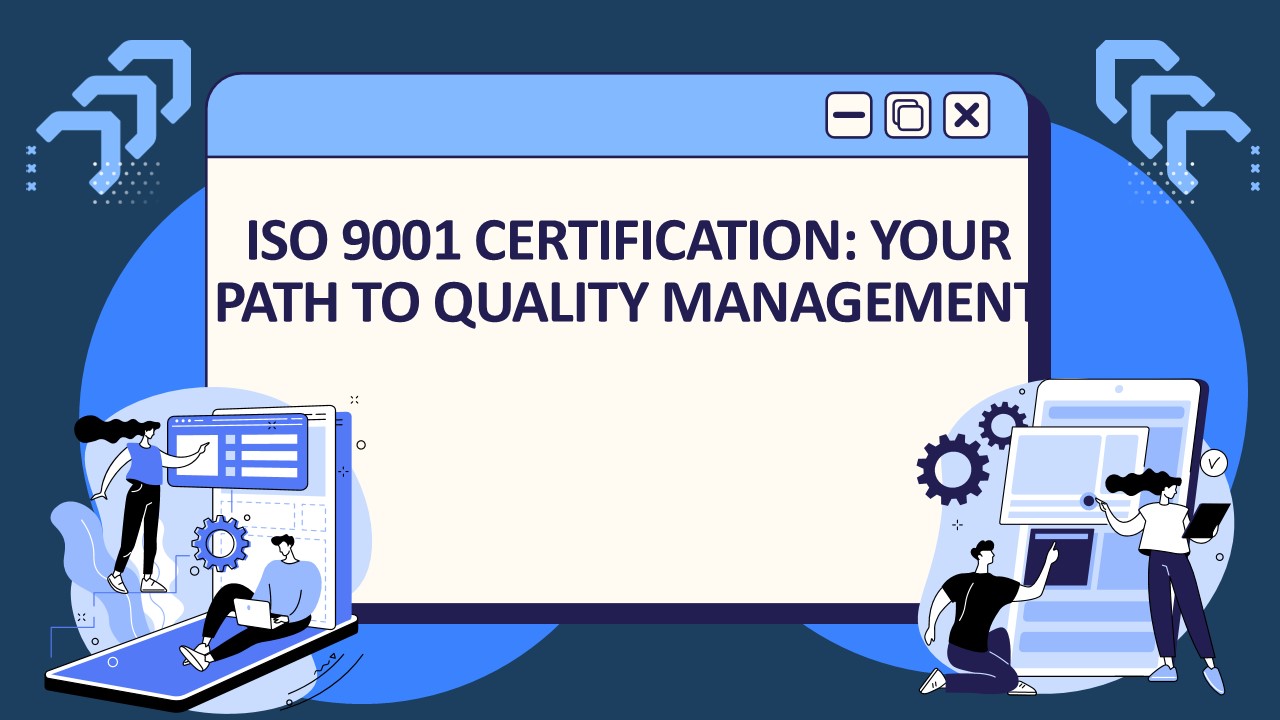ISO 9001 Certification: Your Path to Quality Management - PowerPoint PPT Presentation
Title:
ISO 9001 Certification: Your Path to Quality Management
Description:
ISO 9001 certification is an international standard for quality management systems (QMS) that helps organizations enhance customer satisfaction and operational efficiency. It focuses on principles such as customer focus, leadership, and continuous improvement. The certification process involves gap analysis, QMS development, training, implementation, and external audits, leading to improved processes, increased trust, and access to new markets. – PowerPoint PPT presentation
Number of Views:1
Title: ISO 9001 Certification: Your Path to Quality Management
1
ISO 9001 CERTIFICATION YOUR PATH TO QUALITY
MANAGEMENT
2
INDEX
- Overview of ISO 9001 certification
- Importance of quality management in todays
competitive landscape. - Key Principles of ISO 9001
- Benefits of ISO 9001 Certification
- The Certification Process
- Documentation Requirements
- Common Challenges in Certification
- Continuous Improvement with ISO 9001
- ISO 9001 certification achieved through methods
- Conclusion
3
OVERVIEW OF ISO 9001 CERTIFICATION
ISO 9001 certification is an international
standard for quality management systems (QMS)
that helps organizations enhance customer
satisfaction and operational efficiency. It
focuses on principles such as customer focus,
leadership, and continuous improvement. The
certification process involves gap analysis, QMS
development, training, implementation, and
external audits, leading to improved processes,
increased trust, and access to new markets.
4
IMPORTANCE OF QUALITY MANAGEMENT IN TODAYS
COMPETITIVE LANDSCAPE.
Quality management through ISO 9001
certification is vital in todays competitive
landscape, ensuring consistent product and
service quality. It enhances customer
satisfaction, fosters loyalty, and promotes
continuous improvement and operational
efficiency. Organizations certified in ISO 9001
gain a competitive advantage, demonstrating a
commitment to quality that attracts customers and
opens up new market opportunities for sustainable
growth.
5
KEY PRINCIPLES OF ISO 9001
- Customer Focus
- Leadership
- Engagement of People
- Process Approach
- Improvement
- Evidence-Based Decision Making
- Relationship Management
6
- BENEFITS OF ISO 9001 CERTIFICATION
- Improved operational efficiency.
- Enhanced customer trust and loyalty.
- Access to new markets and business opportunities.
- Better risk management and decision-making
processes.
7
THE CERTIFICATION PROCESS
- Understanding ISO 9001 Requirements
- Conducting a Gap Analysis
- Developing and Documenting a QMS
- Training Employees
- Implementing the QMS
- Conducting Internal Audits
- Management Review
- Certification Audit by an External Body
8
- DOCUMENTATION REQUIREMENTS
Quality Policy
Quality Objectives
Process Descriptions
Records and Reports
Internal Audit Procedures
9
COMMON CHALLENGES IN CERTIFICATION
- Resistance to change from employees.
- Maintaining documentation and compliance.
- Ensuring effective communication across
departments.
10
CONTINUOUS IMPROVEMENT WITH ISO 9001
- Enhanced Efficiency
- Innovation
- Employee
- Adaptability
- Quality Improvement
- Competitive Advantage
- Sustainable Growth
11
ISO 9001 CERTIFICATION ACHIEVED THROUGH METHODS
- Surveys and Questionnaires
- Internal Audits
- Management Reviews
- Focus Groups
- Customer Complaints
- Note Apply for iso 14001 certification
12
CONCLUSION
In conclusion, ISO 9001 certification is a vital
asset for organizations striving for excellence
in quality management. It establishes a
structured framework that enhances customer
satisfaction, operational efficiency, and
continuous improvement. By adhering to ISO 9001
standards, businesses can demonstrate their
commitment to quality, gain a competitive
advantage, and foster trust among customers and
stakeholders. The certification process not only
identifies areas for enhancement but also
encourages a culture of accountability and
innovation. Ultimately, ISO 9001 certification
paves the way for sustainable growth, positioning
organizations for long-term success in an
ever-evolving marketplace.
13
CONTACT US
Phone
8678846088
care_at_isoregistrar.org
website
https//isoregistrar.org/iso-9001-2015-certificate
.php
14
THANK YOU































